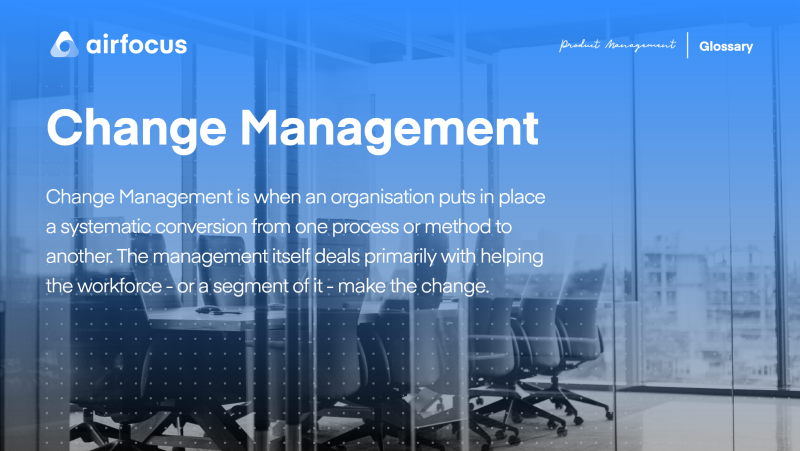Change Management
What is change management?
Definition of change management
Change management is when an organization puts in place a systematic conversion from one process or method to another. The management itself deals primarily with helping the workforce - or a segment of it - make the change. By helping staff make the transition in stages or with guidance, the organization is attempting to allay any frustration, anxiety, or fear. A well-executed change management program creates a smooth and happy path from one process, system, or method to another.
As a discipline, change management has been in existence for several decades and there are a considerable number of product management case studies and research products that can be used as a blueprint for the budding change manager.
Why should change management be used?
It is the nature of the business to want to continually improve since improvement means better practices and ultimately increased profits. However, it is almost impossible for any company to make improvements without making changes. And when an organization wants to make a change, it is going to impact on its most essential asset.
The most important commodity of any organization is its workforce and change management is a concept that is focused on keeping that commodity in a comfortable state. Irrespective of the change the company wants to instigate - shifting product development methodologies or productivity applications, entering a new market, or upgrading fundamental software platforms - that change can only be successful if the workforce is willing or able to embrace it. Indeed, a responsible and conscientious leadership team should be concerned, regardless of how a transition is going to affect any group within their company. This is good leadership. Beyond this though, a successful transition equates to contented employees and contented employees equate to a successful business enterprise. Change Management then is useful because it is able to communicate how the change is a positive thing and provides support to the workforce.
Using established principles of a change management process
Over time and therefore trial and error, businesses have created a number of approaches to devising and rolling out a plan for change management. Furthermore, and especially in regard to product management, the product manager tends to be well-positioned to drive change. With this in mind, change management should become part of said manager’s skill set, which is more learned by practical achievement rather than mastered theory. Almost, unfortunately, those leading a change management program may not see much reward other than the success of the initiative as, by its nature, successful change is seamless if delivered effectively.
A traditional approach would be the following:
Stating reasons and advantages At the very least, at the beginning of a profound change, senior members of an organization cannot expect the workforce to understand why the company must make the proposed transition. At the outset then, sound practice is to show staff why the change is necessary and then demonstrate the benefits to the organization.
Establish who will be affected by the change Gaining a grasp of the breadth of the change will mean getting an understanding of who in the company the changes will affect. In fact, wide business transitions are seldom as simple as defining those who are affected and those who are not. More likely, understanding who will be affected normally means establishing to what extent are different sections of the workforce affected. And then it will be incumbent on senior management to gain an understanding of how the change will affect the way in which each group carries out their job. Decision-makers will need to understand how the changes will disrupt work and plan how to negate those upheavals.
Assign a change management team that also includes product stakeholders Assigning a change management team means you will have individuals completely dedicated to making the transition. Ideally, they should have no other distractions. Without anything else to divert their attention, the change management team can act as a single point of contact (SPoC) for any queries from anyone in the company. Equally, the team will be able to deliver regular updates to decision-makers and the company’s leadership. It is important to include product stakeholders within the change management team. These staff members will be the most affected. Any issues they have will be incorporated into the team and be easier to identify and solve.
Create a change roadmap Creating a roadmap for the planned transition will enable a broad strategic view. The roadmap should not be a detailed list of every tactical change that needs to be implemented but rather should lay out things such as wholesale costs of the project, significant milestones, and a schedule of the transition in its entirety.
Produce a communication plan for the change This plan should lay out any anticipated meetings of the change management team, factor in regular updates to senior management and the wider workforce, and also provide a means by which anyone can view the change roadmap. It is perhaps also useful to provide guidance on how the change management team can be contacted.
Change management benefits
There are a number of discernible business-wide benefits from delivering an effective change management initiative. Firstly, the chances of the transition running smoothly are greatly increased. Also, a bumpy and fraught transition can result in downtime across departments which inevitably leads to increased costs. And a properly delivered change management initiative can lead to improved communication throughout the organization as well as a more satisfied and fulfilled workforce.
On the whole, an organization has to be able to change. This is because the marketplace - especially the technology-driven marketplace - is always evolving. Innovation can sweep through an industry at speed and a company must be willing to change course expeditiously. The key to this is being able to convince the organization’s workforce to change their mindset and their methods. Not being able to reconcile this is to fail wholesale.


Glossary categories
Experience the new way of doing product management

Experience the new way of doing product management








